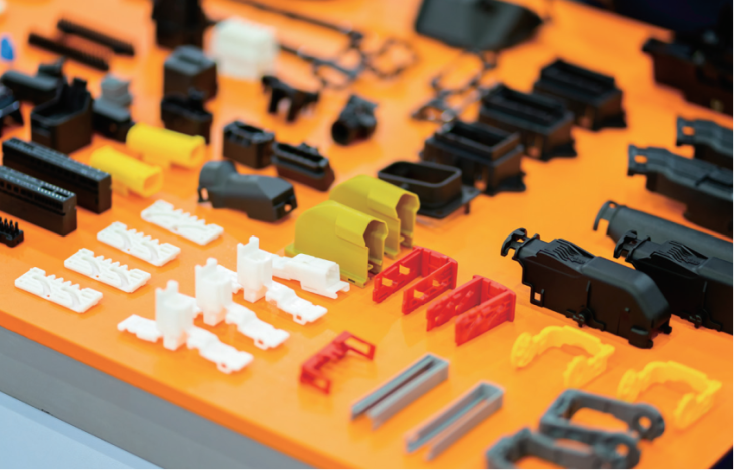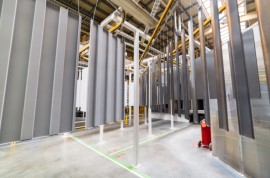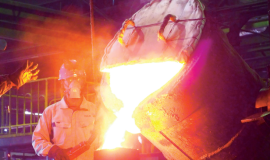People's lifestyles in Vietnam are gradually changing as the country's population and income grow. This contributes to the expansion of the plastic packaging and household plastics markets. At the same time, as the process of urbanization and industrialization continues, the market for construction and engineering plastics is gradually expanding. This article will discuss the plastic injection industry and market trends in Vietnam.

Industry Overview
The plastic injection industry is one of the fastest developing industries in Vietnam nowadays. One reason for that is the development of the national economy and the high youth population in the consuming market. According to a report of the Vietnam Plastics Association, the export turnover of Vietnamese plastic products has grown steadily over the years, from 3 billion USD in 2018 to 5,5 billion USD in 2022, with an average growth rate of 12-20%. The output of imported raw materials also increased from 5,589 million tons in 2018 to 7,12 million tons in 2022. Currently, Vietnam's plastics industry has almost 4000 companies, 90% of which are small and medium companies. The total industry revenue reached above 25 billion USD, with exports accounting for 22%.
These companies are producing a large amount of plastic products for many industries, from plastics used in everyday life to plastics used in the manufacturing industry. Generally, plastic products can be categorized into 4 big groups, which are packaging plastics, household plastics, construction plastics, and engineering plastics.
Packaging plastics
Packaging plays an important role in protecting and promoting products. Plastic is one of the most widely used packaging materials. Although packaging plastic has low added value, it accounts for about 40% of the production value of the plastic industry in Vietnam.
Plastic packaging is mostly used in industries such as food and beverage, spices, pharmaceuticals, healthcare and even in electronic component packaging. To be specific, anti-static aluminum bags/ films are used to preserve electronic components and prevent static electricity.
Common plastic materials used in producing plastic packaging are PET, HDPE, LDPE, PP, PS. Like other industries, the packaging plastics industry also faces a shortage of domestic materials and ends up depending on importing from abroad. Moreover, most of equipment such as injection molding machines, film pelletizing machines, and extrusion machines are also imported from foreign countries. Raw materials are mainly imported from Korea, Japan, China, Taiwan, Thailand, Singapore, USA, Middle East, and other countries, while machinery and equipment are imported at lower costs from Taiwan and China.
Household Plastics
The consumption of plastic products in daily life is often classified according to the following main trends:
- Low-income classes or ordinary shops often consume cheap products, regardless of quality or origin.
- The middle-income class cares more about quality but also considers price. They often choose normal plastic products or imported goods from Japan or Thailand (usually sold at the same price at supermarkets, online stores or stores specializing in imported goods for about 39,000 VND or 79,000 VND).
- High-income classes or people who care about health often choose high-quality plastic products. They especially focus on product safety for users' health, and other factors such as environmental friendliness, durability, and utility.
Nowadays, Vietnamese companies still mostly produce household plastic products with low and medium value. Common plastic products which are often produced and consumed domestically include tables, chairs, food and beverage, etc. These products are often distributed through traditional retail channels such as markets, grocery stores and some supermarkets.
There was a time when this industry was dominated by imported products from abroad, especially from China or Thailand. However, in the past few years, Vietnamese companies have improved quality and design to meet the consumers’ demand and positively promote in the domestic market.
Construction plastics
Plastic construction materials are divided into two main categories: plastic pipes and other materials (axial pressing products, plastic doors, aluminum-plastic alloy panels, mica panels, PP panels, FOMEX panels, etc.).
Plastic pipes are mainly large in size, so domestic products have a more competitive advantage in terms of transportation costs compared to imported products. About 95-98% of plastic pipes sold in Vietnam are domestic products.
In addition, there is a considerable demand for extruded plastic items (such as window frames) and plastic doors. Plastic doors are used in most construction projects, including apartments and office buildings. Despite competition from Chinese goods, domestic products continue to dominate the market with good quality and prices.
In the plastic pipe production process, factories mainly use equipment and production lines from Germany and Italy. Products such as plastic pipes or plastic doors are large in size, requiring large factories and large production equipment. Therefore, only manufacturers with solid financial potential can participate in this field.
Engineering Plastics
Engineering plastic components play a vital role in many industrial products.
Engineering plastic products come in many different types and sizes, mainly used for the automobile - motorbike industry, electronics industry, office machine manufacturing, and component trays. Popular processing methods in Vietnam include injection molding, blow molding, and vacuum molding, with the main materials being thermoplastics. There are a small number of companies that do extrusion, insert molding and two-color molding. Besides, there are a small number of companies that accept thermosetting resins.
Hanoi, Ho Chi Minh City and surrounding areas (the North includes Bac Ninh, Vinh Phuc, Hung Yen, Hai Duong, the South includes Dong Nai, Binh Duong, Long An) have many factories of large companies. Thanks to geographical advantages, as well as infrastructure facilities, plastic injection businesses have concentrated here.
Additionally, there are big differences between Vietnamese businesses and foreign businesses. While Vietnamese enterprises often produce small to medium-sized components, foreign enterprises such as Japan and Korea mainly produce micro or large-sized components. Big manufacturers often order some components from local companies, but for components that are super small in size or have special shapes, or require high precision, foreign companies are still more trusted.
Japanese, Taiwanese, or Chinese machines are used commonly in Vietnam. Since Japanese machinery and equipment are often expensive, not many domestic plastic injection enterprises invest in new equipment from the beginning. A Chinese plastic injection equipment trading company that owns a plastic molding factory in Vietnam said: "Chinese plastic injection machines are among our company's best-selling products. However, I also think that it is necessary to invest in purchasing Japanese equipment to produce high-precision components as Japanese equipment is more stable. In addition, to minimize human errors, more and more businesses are applying robots and conveyors to production. Accordingly, the robot business supporting the plastic molding process has brought profits to our company."
Many plastic molding businesses carry out the printing and painting stages at their factories because these stages are relatively easy. Painting-specific enterprises do exist, but they are quite rare. Motorcycle manufacturing businesses mostly carry out painting in their factories. In addition, there are very few businesses specializing in plating because this job has to meet strict requirements on environmental standards, and there is not much demand for it. Regarding assembly, plastic injection businesses also perform simple assembly, but most client companies perform the assembly themselves at their factories. In the future, when labor costs at large companies increase and wage gaps arise, the need to outsource the assembly of component assemblies may increase.
Regarding plastic injection molds, there are three sources of supply: self-production, outsourcing, or import from abroad. There are also cases where FDI enterprises outsource local companies, but some FDI enterprises said they felt unsatisfied with the quality and delivery time. Some Vietnamese businesses also reported the same thing. To meet customer needs, some businesses that initially specialized in mold manufacturing have expanded into the field of plastic injection. On the contrary, to ensure stability in production and delivery times, many plastic injection factories have conducted their own mold production internally.
A Vietnamese plastic injection business shared: "Currently we are ordering molds from outside but still plan to make our own molds. Some mold companies that we ordered made molds without understanding factors such as thermal deformation of materials, so if we used molds made by them for production, the product would have a high error rate. We tried to fix this problem many times but still couldn't improve, so in the end we canceled the contract. We lost hundreds of millions dong for this expensive lesson. After that, we went to Japan to look for partners who could provide technical guidance, and we were surprised at the Japanese companies' in-depth knowledge despite their small scale."
Currently, in Vietnam, there is no specialized training school for mold design and manufacturing, all are based on accumulated work experience.
Material problem
Nowadays, Vietnam has emerged as a stable investment destination for foreign businesses and is considered a bright candidate for the "China + 1" strategy of many companies. Vietnamese plastic injection companies have more opportunities to meet more diverse orders from international customers. However, one problem that causes many plastic injection businesses to hesitate when facing such great opportunities is the inability to meet customers' price requirements. One of the reasons why competing on price with Chinese businesses has become more difficult is because Vietnamese businesses still have to rely heavily on imported plastic raw materials.
Currently, the domestic supply of plastic materials can only meet 30% of the needs of plastic injection businesses, which provide mainly PVC, PET, and PP. Businesses still have to import the majority of raw materials and input materials for plastic production. Import markets include countries and territories such as Saudi Arabia, Korea, Thailand, Japan, America, China, Taiwan, Malaysia, Singapore, etc.
Dependence on imported raw materials causes raw material costs at plastic injection enterprises to increase, leading to risks such as exchange rate changes, oil price and raw material price fluctuations on the international market. In addition, the large amount of imported input materials will make it difficult for companies exporting plastic products to take advantage of tax incentives due to regulations related to the origin of goods. The issue of not being able to be self-sufficient in raw materials source has long become a major limitation of the Vietnamese plastic injection industry. However, according to many experts, it is still very difficult to change this problem in the next few years.
Future plastic industry trends
Demand for plastic injection products is expected to keep growing in the future, especially engineering plastic products to serve the automotive and electronics sectors - two important industries that are expected to grow positively in the future. Plastic products used in these two fields require special properties such as durability, hardness, corrosion resistance, and temperature resistance, meeting high technical standards. As stated above, currently in Vietnam, the production of engineering plastic injection products with high difficulty requirements is mostly done by foreign enterprises. However, if Vietnamese businesses can participate in this field, there will be great development opportunities.
Automation is becoming a prominent trend in the manufacturing and processing industry in general and the plastic injection industry in particular. More and more businesses are interested in applying robots and automation systems to production stages (inspection, packaging...) or in factory management. Automation brings many significant benefits to businesses. Not only does it help businesses improve production efficiency and reduce errors but also helps reduce labor costs, which are gradually increasing in Vietnam.
The green consumption trend in the world is expected to greatly affect the plastic injection industry. Currently, the environmentally friendly characteristics of plastic products are gradually becoming one of the important factors that consumers will consider when making purchasing decisions. Some of Vietnam's main plastic product export markets, such as the US and Europe, are introducing increasingly strict requirements for imported plastic products (plastic products are recyclable, decomposable or not, does the production process pollute the environment or not, etc.). Faced with these requirements, businesses are forced to adjust production and product development strategies to respond to market trends.
Thank you for the cooperation of the following businesses: Sansho JK Hanoi Co., Ltd, Ha Noi Industry Trading Investment Joint Stock Company, Sahara Industry Vietnam Co.Ltd, Yuwa Vietnam Co.,Ltd, Daiwa Plastics Thang Long Co., Ltd, SSP Molding Co., Ltd, An Phu Viet Plastics Co., Ltd, Van Long Plastic Co., Ltd, Hikari Vietnam Production and Trading Co., Ltd.




















